Investigation of Biaxial Properties of CFRP with the Novel-Designed Cruciform Specimens
Abstract
1. Introduction
2. Design of the Cruciform Specimen
2.1. Design Criterion
2.2. Geometric Parameter Characterization
2.2.1. Geometric Configuration and Parameters
2.2.2. Effect of Geometric Parameters on the Stress Distribution
3. Specimen Manufacturing and Experimental Setup
3.1. Manufacturing Method
- (a)
- Prepare the required number of layers prepregs and cut them into the shape of the cruciform specimen.
- (b)
- Lay the prepregs on the female mold in the pre-defined layup sequence and close the male mold.
- (c)
- Heat the mold under the manufacturer’s recommended cure cycle and pressure, then demold to obtain the specimens.
- (d)
- Mill the specimens to obtain the transition region and the central test region.
- (a)
- Delimit the edge datum line on the mold. Assemble the metal cushion block with same dimensions of the effective test region on the mold.
- (b)
- Cut the CFRP prepreg into 350 mm × 350 mm. Some of which are cut with different opening sizes in the central area for the realization of variable thickness regions of cruciform specimens. The opening sizes of the cruciform specimens are determined by Equation (6).where is the half of the lay number of loading arm, is the half of the lay number of opening prepreg.
- (c)
- Lay the cut CFRP prepreg according to the edge datum line with the arranged laying subsequences and opening sizes. The laying subsequences of loading arms and effective test area are [90°/0°2]8s and [90°/0°2]2s, respectively.
- (d)
- Close the mold and cure the CFRP plates by hot press. After curing, cut the cured CFRP plates using computer numerical controlled (CNC) machine to obtain the cruciform specimens.
3.2. Experimental Setup
4. Results and Discussion
4.1. Comparison of Different Processing of Cruciform Specimens
4.2. Mechanical Response
- (1)
- Stress–strain curves
- (2)
- DIC results
4.3. Failure Analysis
4.4. Biaxial Failure Envelope
5. Conclusions
- (1)
- The biaxial failure occurs in the central effective test region of the cruciform specimen, verifying the effectiveness of the design and manufacturing method proposed in this paper.
- (2)
- Under various biaxial loading ratios, the stress concentration angle observed by DIC decreases with the decrease in the X-Y axial loading ratio. This is consistent with the final failure angle.
- (3)
- With the decrease in the X-Y axial loading ratio, the specimen tends to break instantaneously under the ultimate stress, and it is easier to observe the large-area bare fiber group caused by delamination in the microstructure.
Author Contributions
Funding
Institutional Review Board Statement
Informed Consent Statement
Data Availability Statement
Conflicts of Interest
References
- Ren, M.; Zhang, X.; Huang, C.; Wang, B.; Li, T. An Integrated Macro/Micro-Scale Approach for in Situ Evaluation of Matrix Cracking in the Polymer Matrix of Cryogenic Composite Tanks. Compos. Struct. 2019, 216, 201–212. [Google Scholar] [CrossRef]
- Huang, C.; Ren, M.; Li, T.; Chang, X.; Cong, J.; Lei, Y. Trans-Scale Modeling Framework for Failure Analysis of Cryogenic Composite Tanks. Compos. Part B 2016, 85, 41–49. [Google Scholar] [CrossRef]
- Hamori, H.; Kumazawa, H.; Higuchi, R.; Yokozeki, T. Gas Permeability of CFRP Cross-Ply Laminates with Thin-Ply Barrier Layers under Cryogenic and Biaxial Loading Conditions. Compos. Struct. 2020, 245, 112326. [Google Scholar] [CrossRef]
- Zhang, X.; Li, T.; Huang, C.; Huang, Q.; Ren, M.; Wang, B. Determining the Fiber/Matrix Interfacial Shear Strength under Cryogenic Conditions by Statistical Inversion. Polym. Compos. 2021, 42, 439–449. [Google Scholar] [CrossRef]
- Chen, J.; Wan, L.; Ismail, Y.; Ye, J.; Yang, D. A Micromechanics and Machine Learning Coupled Approach for Failure Prediction of Unidirectional CFRP Composites under Triaxial Loading: A Preliminary Study. Compos. Struct. 2021, 267, 113876. [Google Scholar] [CrossRef]
- Liao, B.; Jia, L.; Zhou, J.; Lei, H.; Gao, R.; Lin, Y.; Fang, D. An Explicit–Implicit Combined Model for Predicting Residual Strength of Composite Cylinders Subjected to Low Velocity Impact. Compos. Struct. 2020, 247, 112450. [Google Scholar] [CrossRef]
- Antoniou, A.E.; Van Hemelrijck, D.; Philippidis, T.P. Failure Prediction for a Glass/Epoxy Cruciform Specimen under Static Biaxial Loading. Compos. Sci. Technol. 2010, 70, 1232–1241. [Google Scholar] [CrossRef]
- Prabhu, G.; Katakam, V.; Sridharan, V.S.; Idapalapati, S. Uniaxial Tensile Failure of Multi-Core Asymmetric Sandwich Composite Structures with Bonded Repair. Compos. Struct. 2019, 224, 111025. [Google Scholar] [CrossRef]
- Na, W.; Lee, G.; Sung, M.; Han, H.N.; Yu, W.R. Prediction of the Tensile Strength of Unidirectional Carbon Fiber Composites Considering the Interfacial Shear Strength. Compos. Struct. 2017, 168, 92–103. [Google Scholar] [CrossRef]
- Bhuiyan, F.H.; Sanei, S.H.R.; Fertig, R.S. Predicting Variability in Transverse Effective Elastic Moduli and Failure Initiation Strengths in UD Composite Microstructures Due to Randomness in Fiber Location and Morphology. Compos. Struct. 2020, 237, 111887. [Google Scholar] [CrossRef]
- Garulli, T.; Catapano, A.; Fanteria, D.; Huang, W.; Jumel, J.; Martin, E. Experimental Assessment of Fully-Uncoupled Multi-Directional Specimens for Mode I Delamination Tests. Compos. Sci. Technol. 2020, 200, 108421. [Google Scholar] [CrossRef]
- Liu, G.; Zhang, L.; Guo, L.; Liao, F.; Zheng, T.; Zhong, S. Multi-Scale Progressive Failure Simulation of 3D Woven Composites under Uniaxial Tension. Compos. Struct. 2019, 208, 233–243. [Google Scholar] [CrossRef]
- Hu, Z.; Chen, M.H.; Zu, L.; Jia, X.; Shen, A.; Yang, Q.; Xu, K. Investigation on Failure Behaviors of 70 MPa Type IV Carbon Fiber Overwound Hydrogen Storage Vessels. Compos. Struct. 2021, 259, 113387. [Google Scholar] [CrossRef]
- Nebe, M.; Asijee, T.J.; Braun, C.; van Campen, J.M.J.F.; Walther, F. Experimental and Analytical Analysis on the Stacking Sequence of Composite Pressure Vessels. Compos. Struct. 2020, 247, 112429. [Google Scholar] [CrossRef]
- Wu, Q.; Wang, Q.; Ren, S.; Zu, L.; Zhang, Q.; Zhang, G. Perforation of Carbon Fiber-Wound Composite Cylinders Struck by Hemispherical and Conical-Nosed Impactors. Compos. Struct. 2021, 259, 113455. [Google Scholar] [CrossRef]
- Wang, Q.; Li, T.; Wang, B.; Liu, C.; Huang, Q.; Ren, M. Prediction of Void Growth and Fiber Volume Fraction Based on Filament Winding Process Mechanics. Compos. Struct. 2020, 246, 112432. [Google Scholar] [CrossRef]
- Liu, G.; Gao, H.; Wei, G.; Ma, Y. A Novel Structure Design of Braided Composite Pressure Vessel and Its Mechanical Analysis. J. Text. Inst. 2019, 110, 124–133. [Google Scholar] [CrossRef]
- Bai, J.; Wang, Z.; Sobey, A.; Shenoi, A. Micromechanical Model for Rapid Prediction of Plain Weave Fabric Composite Strengths under Biaxial Tension. Compos. Struct. 2021, 255, 112888. [Google Scholar] [CrossRef]
- He, R.; Sun, X.; Wu, Y.; Tang, G.; Carvelli, V. Biaxial Tearing Properties of Woven Coated Fabrics Using Digital Image Correlation. Compos. Struct. 2021, 272, 114206. [Google Scholar] [CrossRef]
- Skinner, T.; Datta, S.; Chattopadhyay, A.; Hall, A. Fatigue Damage Behavior in Carbon Fiber Polymer Composites under Biaxial Loading. Compos. B Eng. 2019, 174, 106942. [Google Scholar] [CrossRef]
- Greco, F.; Leonetti, L.; Medaglia, C.M.; Penna, R.; Pranno, A. Nonlinear Compressive Failure Analysis of Biaxially Loaded Fiber Reinforced Materials. Compos. B Eng. 2018, 147, 240–251. [Google Scholar] [CrossRef]
- Du, K.; Huang, S.; Shi, M.; Li, L.; Huang, H.; Zhang, S.; Zheng, W.; Yuan, X. Effects of Biaxial Tensile Mechanical Properties and Non-Integer Exponent on Description Accuracy of Anisotropic Yield Behavior. Mater. Des. 2021, 212, 110210. [Google Scholar] [CrossRef]
- Rashidi, A.; Milani, A.S. A Multi-Step Biaxial Bias Extension Test for Wrinkling/de-Wrinkling Characterization of Woven Fabrics: Towards Optimum Forming Design Guidelines. Mater. Des. 2018, 146, 273–285. [Google Scholar] [CrossRef]
- Daniel, I.; Whitney, J.; Pipes, R. Experimental Mechanics of Fiber Reinforced Composite Materials. Exp. Tech. 1983, 7, 25. [Google Scholar] [CrossRef]
- Smits, A.; Van Hemelrijck, D.; Philippidis, T.P.; Cardon, A. Design of a Cruciform Specimen for Biaxial Testing of Fibre Reinforced Composite Laminates. Compos. Sci. Technol. 2006, 66, 964–975. [Google Scholar] [CrossRef]
- Moreno, M.C.S.; Cela, J.J.L. Failure Envelope under Biaxial Tensile Loading for Chopped Glass-Reinforced Polyester Composites. Compos. Sci. Technol. 2011, 72, 91–96. [Google Scholar] [CrossRef]
- Welsh, J.S.; Adams, D.F. An Experimental Investigation of the Biaxial Strength of IM6/3501-6 Carbon/Epoxy Cross-Ply Laminates Using Cruciform Specimens. Compos. Part A Appl. Sci. Manuf. 2002, 33, 829–839. [Google Scholar] [CrossRef]
- Makris, A.; Vandenbergh, T.; Ramault, C.; Van Hemelrijck, D.; Lamkanfi, E.; Van Paepegem, W. Shape Optimisation of a Biaxially Loaded Cruciform Specimen. Polym. Test. 2010, 29, 216–223. [Google Scholar] [CrossRef]
- Gower, M.R.L.; Shaw, R.M. Towards a Planar Cruciform Specimen for Biaxial Characterisation of Polymer Matrix Composites. In Applied Mechanics and Materials; Trans Tech Publications, Ltd.: Wollerau, Switzerland, 2010; Volume 24, pp. 115–120. [Google Scholar]
- Gan, K.W.; Allegri, G.; Hallett, S.R. A Simplified Layered Beam Approach for Predicting Ply Drop Delamination in Thick Composite Laminates. Mater. Des. 2016, 108, 570–580. [Google Scholar] [CrossRef]
- Vidyashankar, B.R.; Murty, A.V.K. Analysis of Laminates with Ply Drops. Compos. Sci. Technol. 2001, 61, 749–758. [Google Scholar] [CrossRef]
- Lamkanfi, E.; Van Paepegem, W.; Degrieck, J.; Ramault, C.; Makris, A.; Van Hemelrijck, D. Strain Distribution in Cruciform Specimens Subjected to Biaxial Loading Conditions. Part 2: Influence of Geometrical Discontinuities. Polym. Test. 2010, 29, 132–138. [Google Scholar] [CrossRef]
- Pagano, N.J.; Pipes, R.B. Interlaminar Stresses in Composite Laminates under Uniform Axial Extension(Composite Laminates under Uniform Axial Strain, Determining Interlaminar Stresses and Displacements by Finite Difference Techniques). J. Compos. Mater. 1970, 4, 538–548. [Google Scholar]
- Correa, E.; Barroso, A.; Pérez, M.D.; París, F. Design for a Cruciform Coupon Used for Tensile Biaxial Transverse Tests on Composite Materials. Compos. Sci. Technol. 2017, 145, 138–148. [Google Scholar] [CrossRef]
- Hashin, Z.; Rotem, A. A Fatigue Failure Criterion for Fiber Reinforced Materials. J. Compos. Mater. 1973, 7, 448–464. [Google Scholar] [CrossRef]
- Wang, Q.; Li, T.; Yang, X.; Wang, K.; Wang, B.; Ren, M. Prediction and Compensation of Process-Induced Distortions for L-Shaped 3D Woven Composites. Compos. Part A Appl. Sci. Manuf. 2021, 141, 106211. [Google Scholar] [CrossRef]
- Wang, Q.; Li, T.; Yang, X.; Huang, Q.; Wang, B.; Ren, M. Multiscale Numerical and Experimental Investigation into the Evolution of Process-Induced Residual Strain/Stress in 3D Woven Composite. Compos. Part A Appl. Sci. Manuf. 2020, 135, 105913. [Google Scholar] [CrossRef]
- Norris, C. Strength of Orthotropic Materials Subjected to Combined Stresses; United States Department of Agriculture Forest Service: Washington, DC, USA, 1962. [Google Scholar]
- Kobeissi, A.; Rahme, P.; Leotoing, L.; Guines, D. Strength Characterization of Glass/Epoxy Plain Weave Composite under Different Biaxial Loading Ratios. J. Compos. Mater. 2020, 54, 2549–2563. [Google Scholar] [CrossRef]
- Welsh, J.S.; Mayes, J.S.; Key, C.T.; McLaughlin, R.N. Comparison of MCT Failure Prediction Techniques and Experimental Verification for Biaxially Loaded Glass Fabric-Reinforced Composite Laminates. J. Compos. Mater. 2004, 38, 2165–2181. [Google Scholar] [CrossRef]
- Soden, P.D.; Hinton, M.J.; Kaddour, A.S. A Comparison of the Predictive Capabilities of Current Failure Theories for Composite Laminates. Compos. Sci. Technol. 1998, 58, 1225–1254. [Google Scholar] [CrossRef]

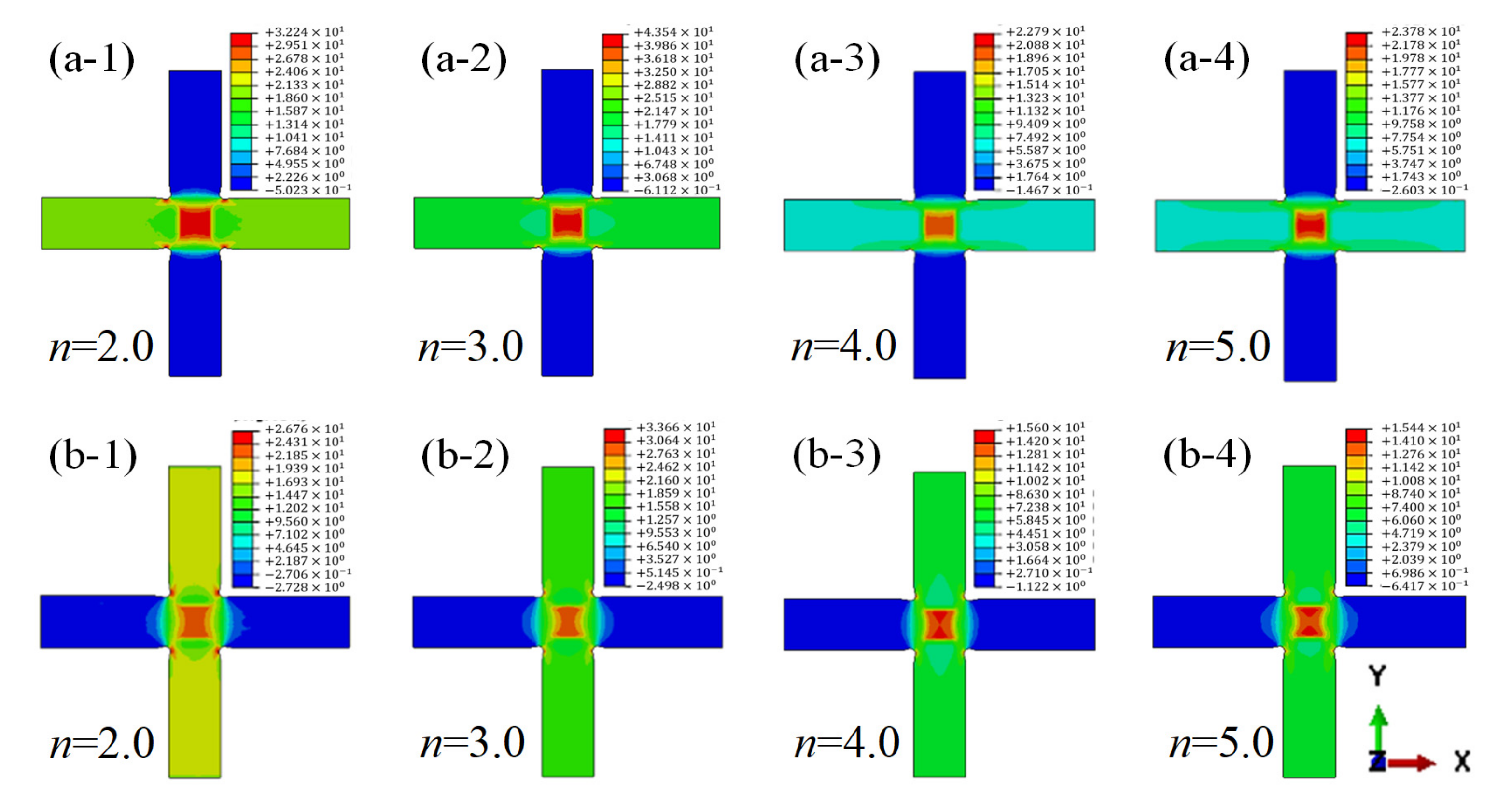

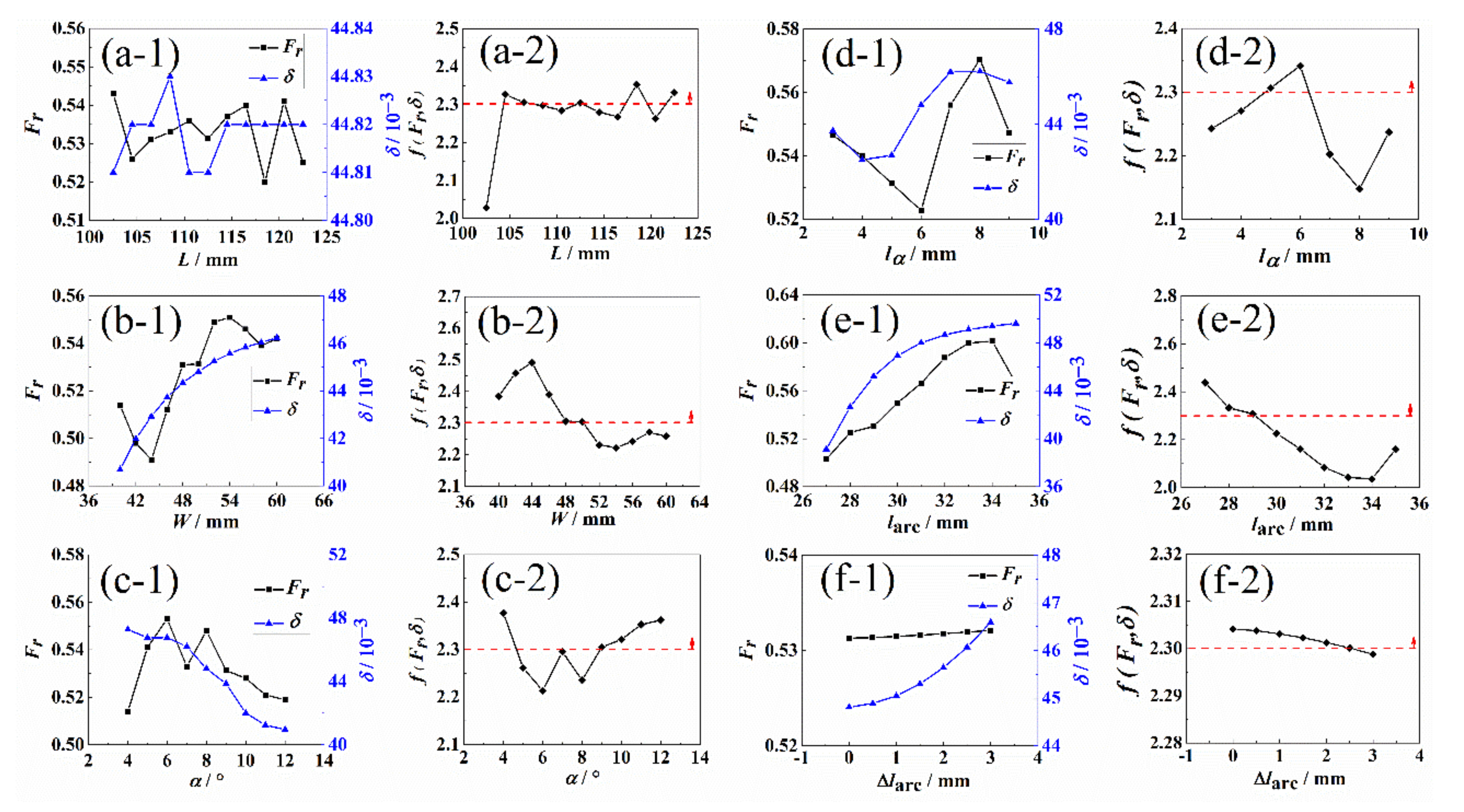

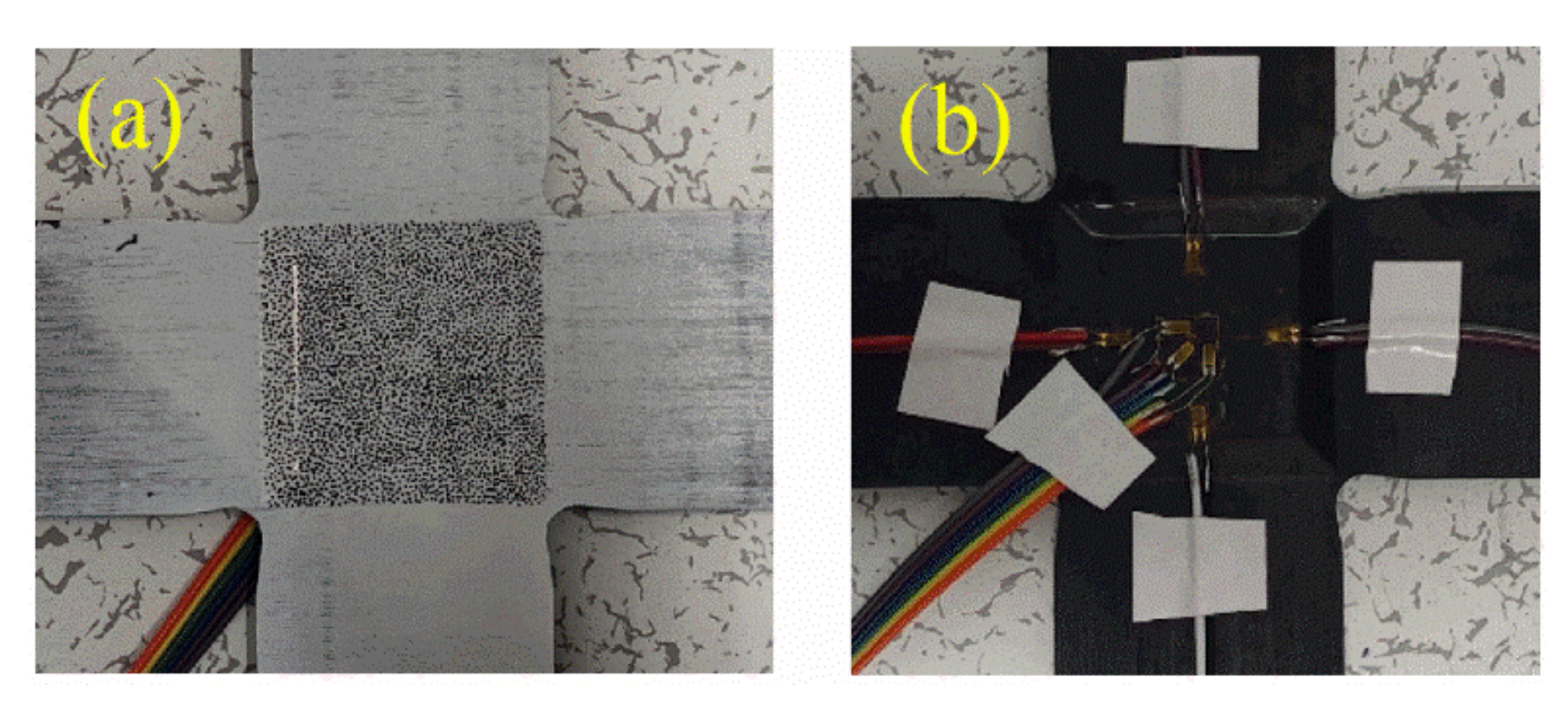


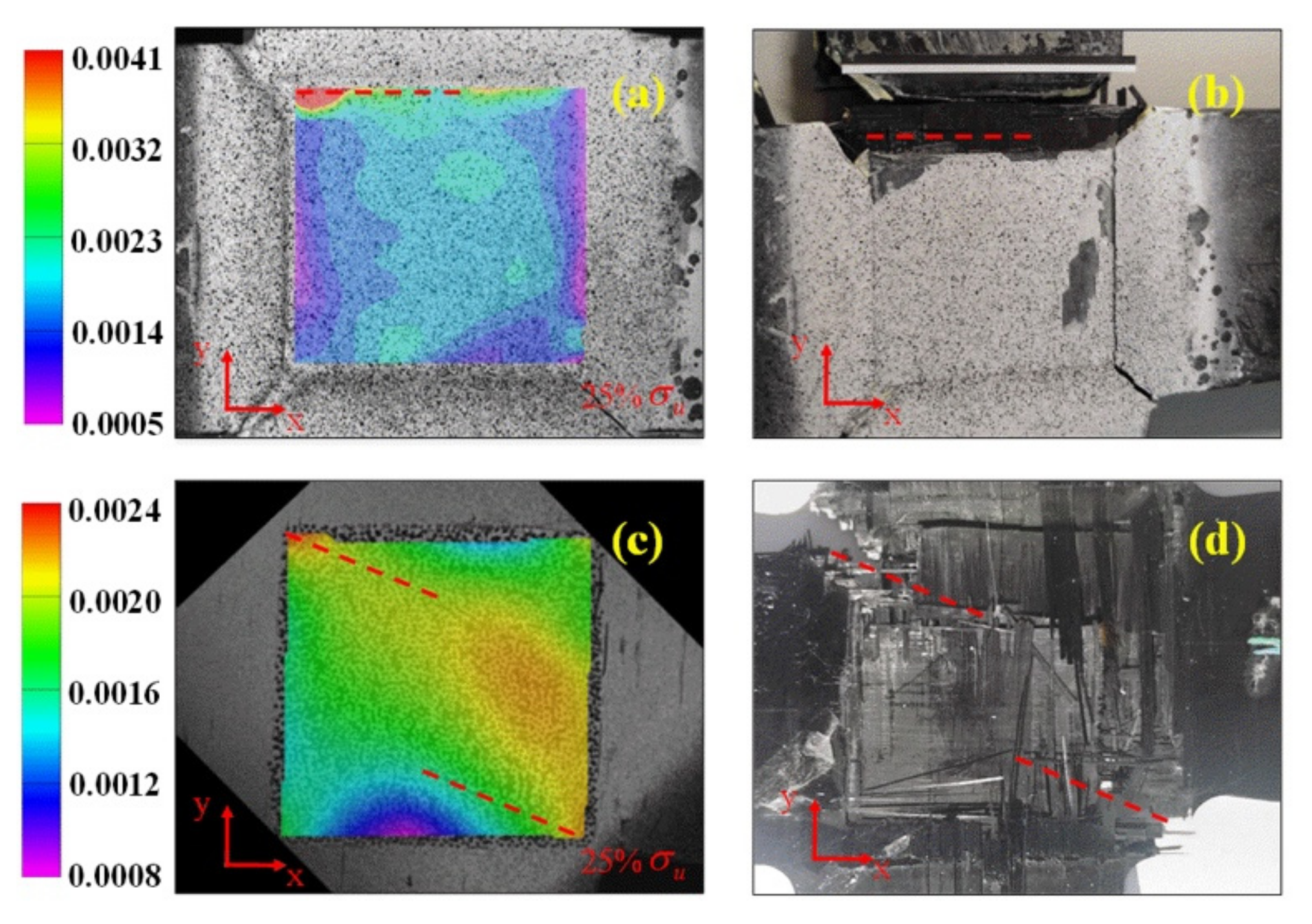
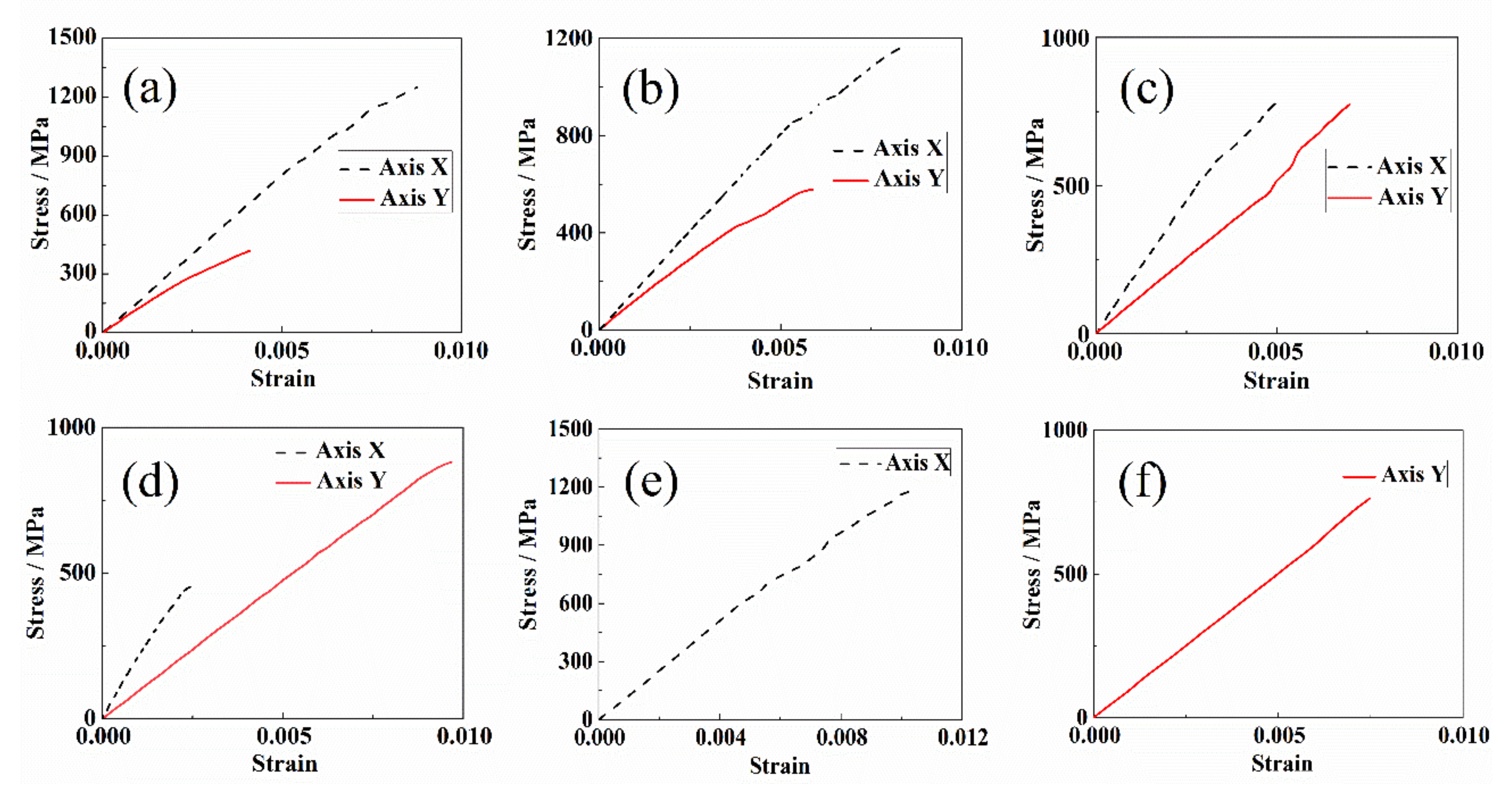
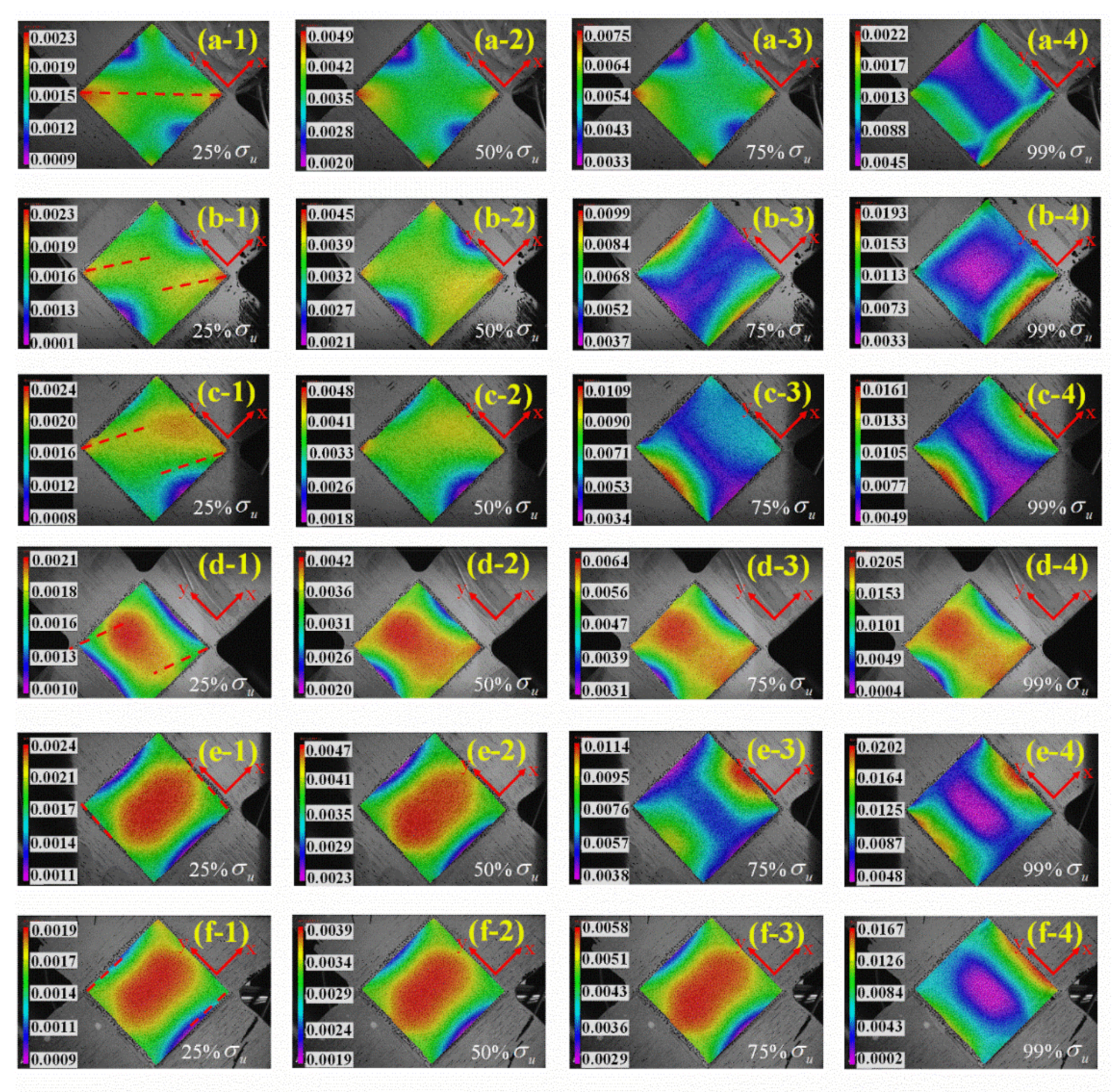


| Geometric Parameters | Symbol | Values before Optimization |
|---|---|---|
| Length of loading arm | 112.5 mm | |
| Width of loading arm | 50 mm | |
| Necking angle | 8° | |
| Distance between necking angle and transition area | 6 mm | |
| Distance between center of transition arc and center of cruciform specimen | 29 mm | |
| Thickness of the effective test region | 1.5 mm | |
| Radius of transition arc | 5.4 mm | |
| Chamfering of the effective test region | 4 mm | |
| Side length of the effective test region | 36 mm | |
| Side length of central variable thickness region | 48 mm |
| E1/GPa | E2/GPa | E3/GPa | G12/GPa | G13/GPa | G23/GPa | μ12 | μ13 | μ23 |
|---|---|---|---|---|---|---|---|---|
| 125 | 9.75 | 9.75 | 7.5 | 7.5 | 5.3 | 0.318 | 0.318 | 0.318 |
Publisher’s Note: MDPI stays neutral with regard to jurisdictional claims in published maps and institutional affiliations. |
© 2022 by the authors. Licensee MDPI, Basel, Switzerland. This article is an open access article distributed under the terms and conditions of the Creative Commons Attribution (CC BY) license (https://creativecommons.org/licenses/by/4.0/).
Share and Cite
Zhang, X.; Zhu, H.; Lv, Z.; Zhao, X.; Wang, J.; Wang, Q. Investigation of Biaxial Properties of CFRP with the Novel-Designed Cruciform Specimens. Materials 2022, 15, 7034. https://doi.org/10.3390/ma15197034
Zhang X, Zhu H, Lv Z, Zhao X, Wang J, Wang Q. Investigation of Biaxial Properties of CFRP with the Novel-Designed Cruciform Specimens. Materials. 2022; 15(19):7034. https://doi.org/10.3390/ma15197034
Chicago/Turabian StyleZhang, Xiaowen, Haiyang Zhu, Zhixing Lv, Xiangrun Zhao, Junwei Wang, and Qi Wang. 2022. "Investigation of Biaxial Properties of CFRP with the Novel-Designed Cruciform Specimens" Materials 15, no. 19: 7034. https://doi.org/10.3390/ma15197034
APA StyleZhang, X., Zhu, H., Lv, Z., Zhao, X., Wang, J., & Wang, Q. (2022). Investigation of Biaxial Properties of CFRP with the Novel-Designed Cruciform Specimens. Materials, 15(19), 7034. https://doi.org/10.3390/ma15197034





